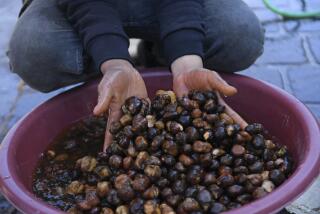Islamic State smashes Palmyra artifacts; UNESCO calls it ‘industrial scale’ destruction
The future does not bode well for the ancient archaeological site of Palmyra in Syria -- or any other archaeological sites within reach of Islamic State militants.
Images released over the last two days by militants in the region show a man smashing statues that are purported to have come from Palmyra. Also reputedly destroyed is the Lion of al-Lat, a 15-ton, 2,000-year-old statue that once guarded the temple of al-Lat, in honor of a pre-Islamic Arabian goddess. And National Geographic is reporting that militants have placed explosive devices around the ancient ruins.
Michael Danti, co-director of the Syrian Heritage Initiative at the American Schools of Oriental Research, told National Geographic that the ongoing destruction wreaked by Islamic State militants represents “the worst cultural heritage crisis since World War II.”
Likewise, at a speech before the Royal United Services Institute in London on Thursday, UNESCO chief Irina Bokova said the ravaging is unparalleled.
“This deliberate destruction is not only continuing, it is happening on a systematic basis,” she said. “The looting of archaeological sites and museums, in Iraq particularly, has reached an industrial scale of destruction.”
As the militants have taken over strategic sections of Syria and Iraq, in addition to ribbons of land along the Libyan coastline, the destruction of ancient historic sites has been part of the group’s modus operandi. Already, the militants have destroyed artifacts in Nineveh, Nimrud and Hatra in Iraq. And they have wreaked havoc on Iraqi medieval architecture.
All of this is in keeping with the group’s austere vision of a pure Islamic caliphate, one that is free of idolatrous objects -- especially those dating to the pre-Islamic era or those strongly identified with the Shiite Islam. (Islamic State militants are Sunni.)
But as the group destroys ancient sites, there are also reports that militants are trafficking in looted objects to fund its military campaigns. An eye-opening article by Rachel Shabi in the Guardian reports that looted artifacts may already be turning up in London antiquities shops.
“What’s certain is that, while [the Islamic State] grimly documents its destruction of UNESCO sites such as Nimrud,” she wrote, “profiteering from plundered antiquities has helped make it the most cash-rich terror group in the world.”
Many of these looted goods, she reported, travel overland through Lebanon and Turkey before arriving in Switzerland or Germany, where they are laundered and fake paper trails created, before landing in the principal antiquities markets of London and New York.
To collectors interested in snatching up some of these ancient artifacts, Near East specialist Mark Altaweel says to think very carefully about what these purchases might be supporting.
“These are blood antiquities,” he told the Guardian. “What might work more is to say that this is funding death.”
Find me on Twitter @cmonstah
More to Read
The biggest entertainment stories
Get our big stories about Hollywood, film, television, music, arts, culture and more right in your inbox as soon as they publish.
You may occasionally receive promotional content from the Los Angeles Times.







